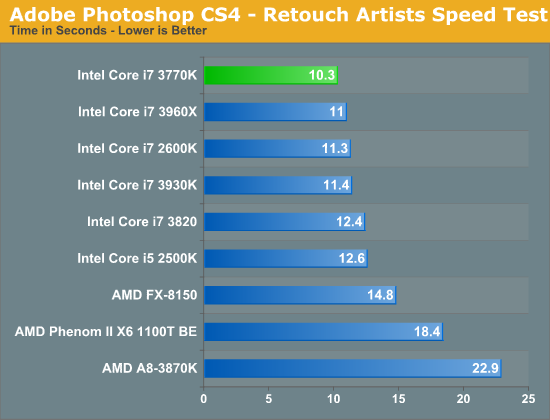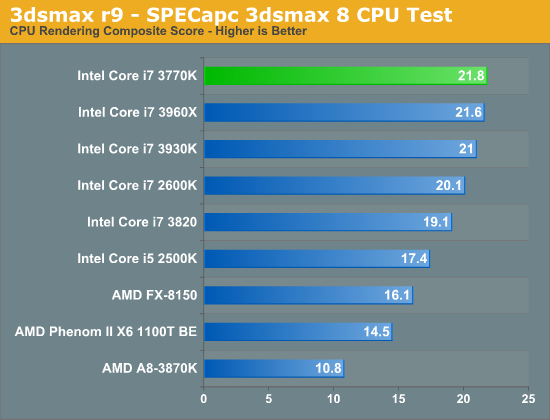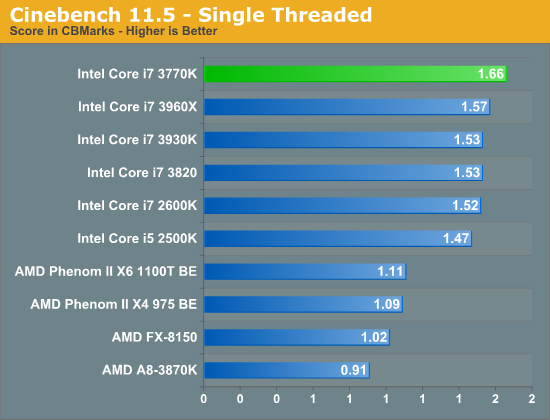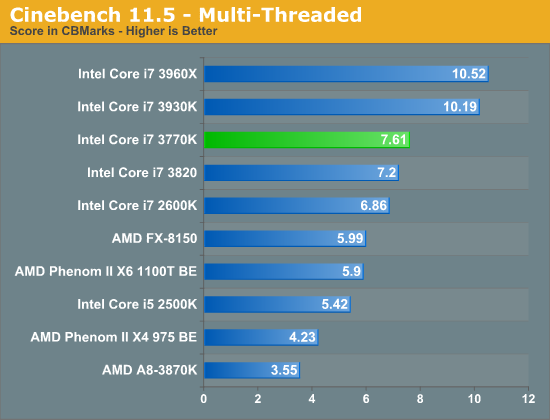The Ivy Bridge Preview: Core i7 3770K Tested
by Anand Lal Shimpi on March 6, 2012 8:16 PM EST- Posted in
- CPUs
- Intel
- Core i7
- Ivy Bridge
Content Creation Performance
Adobe Photoshop CS4
To measure performance under Photoshop CS4 we turn to the Retouch Artists’ Speed Test. The test does basic photo editing; there are a couple of color space conversions, many layer creations, color curve adjustment, image and canvas size adjustment, unsharp mask, and finally a gaussian blur performed on the entire image.
The whole process is timed and thanks to the use of Intel's X25-M SSD as our test bed hard drive, performance is far more predictable than back when we used to test on mechanical disks.
Time is reported in seconds and the lower numbers mean better performance. The test is multithreaded and can hit all four cores in a quad-core machine.

Our Photoshop test is well threaded but it doesn't peg all cores constantly. Instead you get burstier behavior. With the core count advantage out of the way, SNB-E steps aside and allows the 3770K to step up as the fastest CPU we've tested here. The performance advantage over the 2600K is around 9%.
3dsmax 9
Today's desktop processors are more than fast enough to do professional level 3D rendering at home. To look at performance under 3dsmax we ran the SPECapc 3dsmax 8 benchmark (only the CPU rendering tests) under 3dsmax 9 SP1. The results reported are the rendering composite scores.

In another FP heavy workload we see a pretty reasonable gain for Ivy Bridge: 8.5% over a 2600K. This isn't enough to make you want to abandon your Sandy Bridge, but it's a good step forward for a tick.
Cinebench 11.5
Created by the Cinema 4D folks we have Cinebench, a popular 3D rendering benchmark that gives us both single and multi-threaded 3D rendering results.

The single threaded Cinebench test shows a 9% performance advantage for the 3770K over the 2600K. The gap increases slightly to 11% as we look at the multithreaded results:

If you're running a workload that can really stress multiple cores, the 6-core Sandy Bridge E parts will remain unstoppable but in the quad-core world, Ivy Bridge leads the pack.










195 Comments
View All Comments
tipoo - Wednesday, March 7, 2012 - link
Thankfully the comments of a certain troll were removed so mine no longer makes sense, for any future readers.Articuno - Tuesday, March 6, 2012 - link
Just like how overclocking a Pentium 4 resulted in it beating an Athlon 64 and had lower power consumption to boot-- oh wait.SteelCity1981 - Tuesday, March 6, 2012 - link
That's a stupid comment only a stupid fanboy would make AMD is way ahead of Intel in the graphics department and is very competitive with Intel in the mobile segment now.tipoo - Tuesday, March 6, 2012 - link
Your comments would do nothing to inform regular readers of sites like this, we already know more. So please, can it.tipoo - Tuesday, March 6, 2012 - link
Not what I asked little troll. Give a source that says Apple will get a special HD4000 like no other.Operandi - Tuesday, March 6, 2012 - link
What are you talking about? As long as AMD has a better iGPU there is plenty of reason for them to be viable choice today. And if gaming iGPU performance holds on against Intel there is more than just hope of them getting back in the game in terms of high performance comput tomorrow.tipoo - Tuesday, March 6, 2012 - link
I'm pretty sure even 16x AF has a sub 2% performance hit on even the lowest end of todays GPUs, is it different with the HD Graphics? If not, why not just enable it like most people would, even on something like a 4670 I max out AF without thinking twice about it, AA still hurts performance though.IntelUser2000 - Tuesday, March 6, 2012 - link
AF has greater performance impact on low end GPUs. Typically its about 10-15%. It's less on the HD Graphics 3000, only because their 16x AF really only works at much lower levels. It's akin to having option for 1280x1024 resolution, but performing like 1024x768 because it looks like the latter.If Ivy Bridge improved AF quality to be on par with AMD/Nvidia, performance loss should be similar as well.
tipoo - Wednesday, March 7, 2012 - link
Hmm I did not know that, what component of the GPU is involved in that performance hit (shaders, ROPs, etc)? My card is fairly low end and 16x AF performs nearly no different than 0x.Exophase - Wednesday, March 7, 2012 - link
AF requires more samples in cases of high anisotropy so I guess the TMU load increases, which may also increase bandwidth requirements since it could force higher LOD in these cases. You'll only see a performance difference if the AF causes the scene to be TMU/bandwidth limited instead of say, ALU limited. I'd expect this to happen more as you move up in performance, not down, since ALU:TEX ratio tends to go up along the higher end.. but APUs can be more bandwidth sensitive and I think Intel's IGPs never had a lot of TMUs.Of course it's also very scene dependent. And maybe an inferior AF implementation could end up sampling more than a better one.